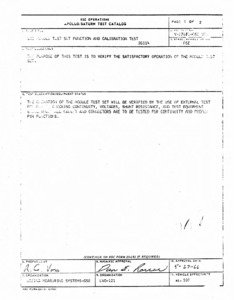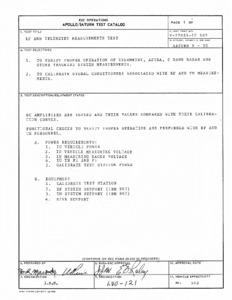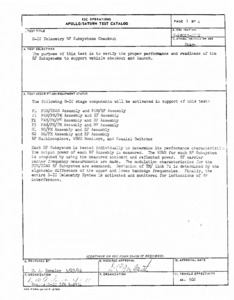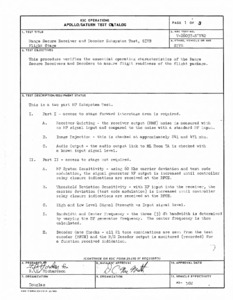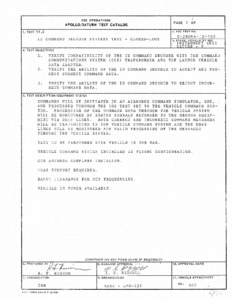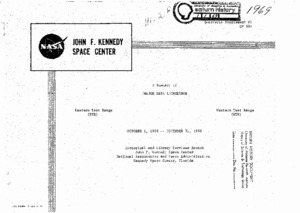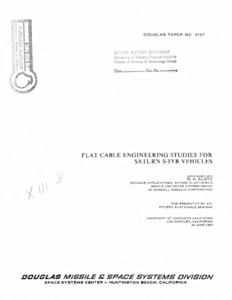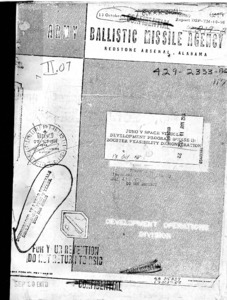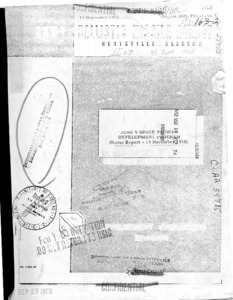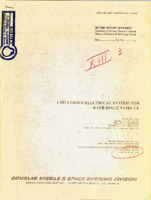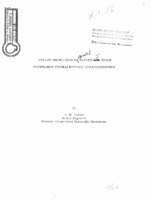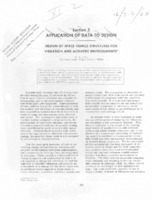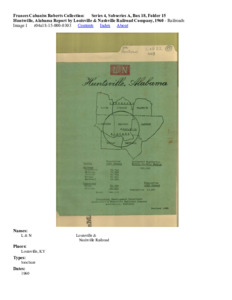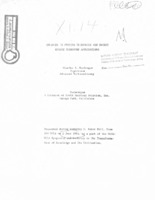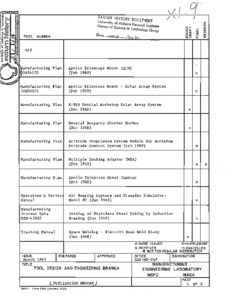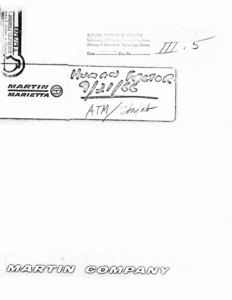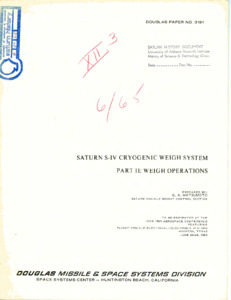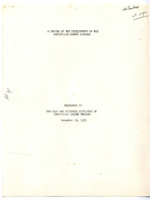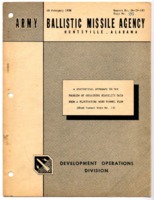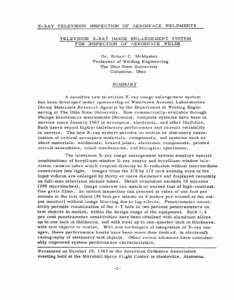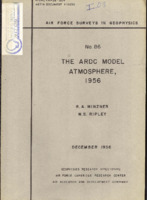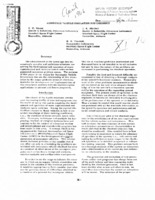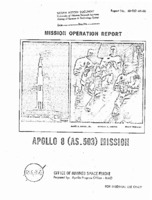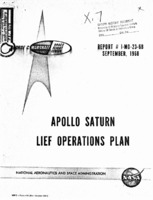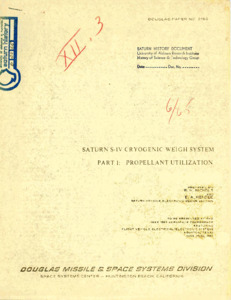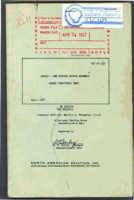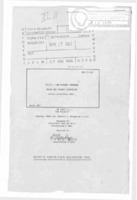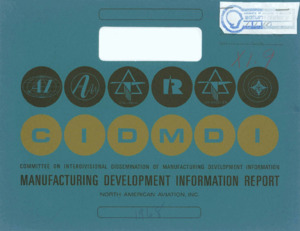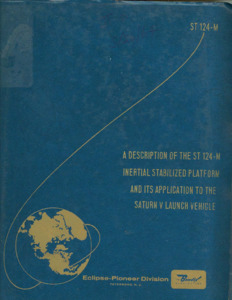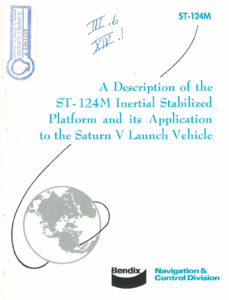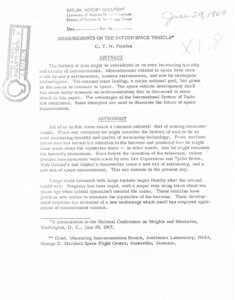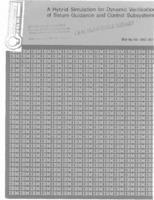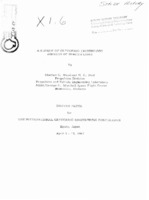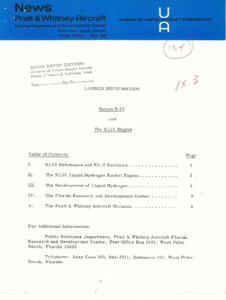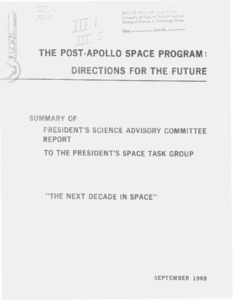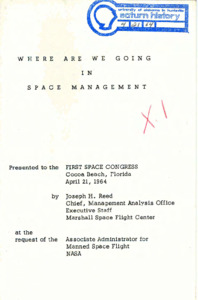
Browse Items (192 total)
Sort by:
-
Catalog of launch vehicle tests Saturn V : Apollo/Saturn 502 : Volume 1, Section 15.
The document is Volume 1, Section 15 of a list of Saturn V launch tests including but not limited to test titles, test numbers, test objectives, and test descriptions related to AS-502. -
Catalog of launch vehicle tests Saturn V : Apollo/Saturn 502 : Volume 1, Section 16.
The document is Volume 1, Section 16 of a list of Saturn V launch tests including but not limited to test titles, test numbers, test objectives, and test descriptions related to AS-502. -
Catalog of launch vehicle tests Saturn V : Apollo/Saturn 502 : Volume 1, Section 17.
The document is Volume 1, Section 17 of a list of Saturn V launch tests including but not limited to test titles, test numbers, test objectives, and test descriptions related to AS-502. -
Catalog of launch vehicle tests Saturn V : Apollo/Saturn 502 : Volume 1, Section 18.
The document is Volume 1, Section 18 of a list of Saturn V launch tests including but not limited to test titles, test numbers, test objectives, and test descriptions related to AS-502. -
Catalog of launch vehicle tests Saturn V : Apollo/Saturn 502 : Volume 1, Section 19.
The document is Volume 1, Section 19 of a list of Saturn V launch tests including but not limited to test titles, test numbers, test objectives, and test descriptions related to AS-502. -
Catalog of launch vehicle tests Saturn V : Apollo/Saturn 502 : Volume 1, Section 20.
The document is Volume 1, Section 20 of a list of Saturn V launch tests including but not limited to test titles, test numbers, test objectives, and test descriptions related to AS-502. -
"A summary of major NASA launchings" between October 1st and December 31st, 1968.
This is the first Quarterly Supplement to the October 1968 edition of GP 381, ''A Summary of Major NASA Launchings (Eastern Test Range and Western Test Range)." This Supplement covers the period from October 1 to December 31, 1968. Two additional Quarterly Supplements will be issued during 1969. Each of these will list those major NASA launchings occurring during the three-month period it covers. The basic publication will be revised and reissued, incorporating the information contained in the Supplements, as well as covering the final three-month period, subsequent to October 1, 1969. William A. Lockyer, Jr. -
"Report to the Congress from the President of the United States"
A report to Congress from White House regarding the accomplishments of NASA. -
"Flat Cable Engineering Studies for Saturn S-IVB Vehicles."
This paper describes the engineering approaches, investigations, results and conclusions of two National Aeronautics and Space Administration (NASA) flat-cable contracts from the George C. Marshall Space Flight Center (MSFC) to the Douglas Aircraft Company, Inc., for feasibility studies on the S-IVB stage of the Saturn Vehicle. In addition, the objectives and approaches for a third contract., "Flat-Cable Engineering Study", are discussed. A sister Douglas Paper No. 4186, to be presented by Dr. P. L. Hill, covers in detail the manufacturing aspects of the Flat-Cable Development Program.; Prepared by R.A. Klotz, Advance applications, Saturn Electronics, Missile and Space Systems Group, McDonnell Douglas Corporation for presentation at: IPC/EDN Flat-Cable Seminar, University of Southern California, Los Angeles, California, 20 June 1967. -
"Juno V Space Vehicle Development Program (Phase I): Booster Feasibility Demonstration."
The initial phase of the JUNO V space vehicle development program, as presented herein, provides for a static demonstration and a total of four flight feasibility tests. The latter two flights will give the U.S. its first payload capability in excess of 10,000 lb in mid 1961. The objective of the overall program is to provide a reliable, economical, and flexible carrier vehicle with relatively large payload capability for orbital and space missions at the earliest possible date. -
"Juno V Space Vehicle Development Program."
This report io the second in a scrics of reports on the JUNO V Space I Vehicle Development Program and indicates the present status of the overall I program. The objective of the overall program is to provide a reliable, economical, and flexible carrier vehicle with relatively large payload capability for orbital and space missions at the earliest possible date. -
"Chilldown Electrical System for S-IVB Space Vehicle."
The paper is marked, "To be presented at the IEEE 1965 Aerospace Conference featuring Flight Vehicle Electrical/Electronics Systems, Houston, Texas, June 20-24, 1965." The abstract states "This paper presents the electrical system used to drive the chilldown motor pumps on the S-IVB space vehicle. This system consists of a 56 volt battery supplying power to the two three-phase solid state inverters which in turn drive two cryogenic motor pumps. Included in this paper is a short description of the overall chilldown system requirements. The advantages of the a-c system over the d-c system are discussed with emphasis on weight and reliability. Two functionally identical 1.5kva inverters were designed. One inverter uses germanium transistors in the output stage while the other uses silicon transistors. Both inverters were designed to have a quasi-square wave output. The inverter circuitry is described and the advantages of each is discussed including a comparison of weight, size, operating temperature, efficiency and voltage rating." Includes diagrams. -
"Analog Simulation of Saturn S-IB Stage Propulsion System Dynamic Characteristics."
This copy has handwritten notes that change the title to read, "Analog Simulation of Uprated Saturn I Stage Propulsion System Dynamic Characteristics." The abstract notes, "The purpose of this paper is to present the techniques and logic employed in the development of an analog computer model to simulate Saturn IV first stage propulsion system dynamic characteristics. Restraints, problem areas, and major assumptions are included." -
"Application of Data to Design: Design of Space Vehicle Structures for Vibration and Acoustic Environments."
According to the abstract, this paper discusses the need for a uniform design approach throughout the aerospace industry for space vehicle structural vibrations in order to keep pace with improvements in environment definition and testing. -
"Advances in Pumping Technology and Rocket Engine Turbopump Applications."
Presented by Charles A. MacGregor, Supervisor, Advanced Turbomachinery during Workshop D, Royce Hall, Room 160 at UCLA on 2 June 1964, as a part of the NASA-UCLA Symposium and Workshop on the Transformation of Knowledge and Its Utilization. The introduction notes, "This report is divided into two general parts. The first part is a description of turbopumps for liquid rocket engines as they exist today. For completeness and understanding, some background information is included on why turbopumps have evolved to their present configurations. The second part suggest portions of this effort that may have some applicability to the general economy." -
"Tool and Engineering Branch publication report."
Report list detailing the state of manufacturing plans as either "Rough" or "Final" drafts. -
"Human Factor: ATM /Skylab."
Statement of work: Man/Machine activities -ATM; ATM problem areas; EVA commuting problem; Other EVA considerations; Analysis of crew considerations Mission 211/212; Mission objectives Crew Considerations; Mission Fight Profile & Operations Crew Considerations; Experiment operations crew considerations; EVA equipment requirements; Crew considerations carrier recommendations; Conclusions and recommendations crew considerations; Crew operations requirements preliminary 10 August 1996; ATM stabilization and control; ATM Carrier habitability and profile; Other ATM man/machine considerations.; Original is a poor photocopy.; Document has no page numbering. -
"Human Factor: ATM/Skylab."
The "Skylab" in the title was a later addition. This is a summary of the human factor aspects of the Apollo Applications space habitat. -
"Saturn S-IV cryogenic weigh system. Part II : weigh operations."
Two basic methods for mass determination are: (1) direct measurement, (2) volume and density determination. Both methods or variations have been used to determine space vehicle propellant mass with varying degrees of success. Stringent propellant loading accuracy requirements of k0.5 percent for the Saturn S-IV Stage have led to the development of a Cryogenic Calibration Weigh System. The method employs accurate electronic force transducers and measuring systems as the standard and experimental weighings have verified achievement of better than the required accuracy. -
"A Review of the Development of the Huntsville Campus Library."
Prepared by Librarian Christel L. McCanless and presented to the Arts and Sciences Committee on Huntsville Degree Program. The document includes a review of library materials and an outline of future plans, including comparisons to collections at other universities. -
"X-ray television inspection of aerospace weldments : Television x-ray image enlargement system for inspection."
A sensitive new television X-ray image enlargement system has been developed under sponsorship of Watertown Arsenal Laboratories (Army Materials Research Agency) by the Department of Welding Engineering of The Ohio State University. Now commercially-available through Philips Electronics Instruments (Norelco), complete systems have been in service since January 1963 in aerospace, electronic, and other facilities. Such users report highly- satisfactory performance and unusual reliability in service. The new X-ray system permits in-motion or stationary examination of critical aerospace materials, components, and systems such as sheet materials, weldments, brazed joints, electronic components, printed circuit assemblies, small mechanisms, and biological specimens. -
"Air Force Surveys in Geophysics: The ARDC Model Atmosphere, 1956."
This paper presents a "realistic model of atmospheric properties based on reliable observations and current theories" according to the abstract found on page xv. This 1956 ARDC model was meant to be used as the "basis for engineering and design work performed." -
"Aerospace Vehicle Simulation and Checkout."
Paper by J. W. Moore and J. R. Mitchell, Quality & Reliability Assurance Laboratory, Marshall Space Flight Center, and H. H. Trauboth, Computation Laboratory, Marshall Space Flight Center. The paper summary notes, "The advancement of the space age into increasingly complex and ambitious missions requiring the development and operation of more sophisticated and intricate launch vehicles has generated numerous problem areas. The purpose of this paper is to define the Aerospace Vehicle Simulation; discuss the relationship of this simulation to the major problem areas of checkout; describe the development and implementation of this simulation system; indicate multidiscipline applications to present and future programs." -
Apollo 8 Mission Operation Report.
This report is meant to provide NASA Senior Management with information on flight plans, mission objectives, and the basis for assessment of mission accomplishment. Note that page 61 is missing from the report. -
"Apollo Saturn LIEF Operations Plan."
This paper identifies the support functions performed by MSFC through the Launch Information Exchange Facility (LIEF) during the Apollo Saturn Mission Operations and other facilities required to carry out these functions. It also identifies mission specific documents required for operation. Note that page 20 is missing. -
"Saturn S-IV cryogenic weigh system. Part I : propellant utilization."
In order to achieve maximum vehicle efficiency, it is essential that the vehicle propellants be loaded to desired values and that these propellants approach simultaneous depletion at the end of powered flight. To accomplish precise loading and assure minimum residuals, a highly accurate and repeatable, vehicle located, propellant management (PM) or propellant utilization (PU) system must be used. As the ability to load propellants to predetermined values depends directly on the ability of the system to accurately sense the propellant masses, it is essential that the system be calibrated with respect to propellant mass under conditions resembling those to be experienced during final loading and powered flight. The use of a cryogenic weight system will reduce the unknown factors in capacitance sensor element shaping, tank geometry, and propellant properties to a degree which will permit the determination of propellant masses to with .025%. -
"Apollo - LEM Docking Drogue Assembly Static Structural Test."
This document contains the tests and test results from structural tests performed on the Apollo LEM docking drogue assembly between January 11, 1967 and February 15, 1967. The document contains various graphs, diagrams, and images pertaining to the tests. -
"Apollo-LEM Docking Combined Probe and Drogue Assemblies Static Structural Test."
This document contains the test technical report and results for the LEM docking probe and drogue assemblies to demonstrate that the assemblies would sustain enough load to capture latch. The document contains various graphs, diagrams, and images from testing. The final page contains a note that page no. A-139 is missing from the report. -
"Manufacturing Development Information Report."
The Committee on Interdivisional Dissemination of Manufacturing Development Information (CIDMDI) is comprised of NR - divisional representatives closely associated with advancement of the manufacturing arts . The purpose of the committee is to impart and receive development information of interest to NR manufacturing areas. Space Division's Central Manufacturing presents this CIDMDI Annual Report, for CFY 1968, in compliance with CIDMDI objectives. Included are research projects conducted by Central Manufacturing,as well as pertinent items submitted by the Apollo and Saturn Projects, for which, acknowledgement and appreciation are extended. Because of the large number of reports contained in this issue, only general information has been presented. Detailed data, if permissible, will be made available on request. For further information, contact L. B. Norwood, Space Division, Extension 1915.; PAP 68-0013.; Prepared by Advanced Projects Section of Central Manufacturing. L. B. Norwood, CIDMDI, Representative. F. H. Burry, Director, Manufacturing. -
"A Description of the ST 124-M Inertial Stabilized Platform and its Application to the Saturn V Launch Vehicle."
This report is a description of the ST124-M inertial stabilized platform system and its application to the Saturn V launch vehicle. It is a summary report providing the system concept and not a theoretical presentation. Mathematical equations were included only where necessary to describe the equipment; however, the detail derivations supporting these equations were not presented since this was not the theme of the paper. -
"A description of the ST-124M inertial stabilized platform and its application to the Saturn V launch vehicle."
This report is a description of the ST-124M inertial stabilized platform system and its application to the Saturn V launch vehicle. It is a summary report providing the system concept, and not a theoretical presentation. Mathematical equations were included only where necessary to describe the equipment; however, the detailed derivations supporting these equations were not presented since this was not the theme of the paper. -
"Measurements on the Saturn space vehicle."
The history of man might be considered as an ever increasing quantity and quality of measurements. Measurements related to space have been made by early astronomers, modern astronomers, and now by aerospace technologists. The manned lunar landing, a major national goal, has given us the means to measure in space. The space vehicle development itself has made heavy demands on instrumentation; this is discussed in some detail in this paper. The advantages of the International System of Units are mentioned. Some examples are used to illustrate the future of space measurement. -
"A Hybrid Simulation for Dynamic Verification of Saturn Guidance and Control Subsystems."
This paper presents a discussion of a hybrid simulation used to dynamically verify the Saturn Guidance and Control subsystems. First, the Saturn vehicle is briefly described to provide background information. The Instrument Unit (IU) is considered in more detail to give a proper setting for the Guidance and Flight Control (G and FC) discussion that follows. After a brief description of the actual G and FC System operation, simulation models of the G and FC components are considered in detail. This is followed by a discussion of the model assignment to a particular computer (digital or analog) and justification for making that assignment. Finally, results of the AS-204/LM1 hybrid simulation studies are briefly considered with mention of the actual flight data. -
"A Review of Cryogenic Technology Aspects of Space Flight."
This paper was presented at the International Cryogenic Engineering Conference in Kyoto, Japan. It details the use of cryogenic technology in rocketry and how its usage created "many new techniques and deeply stimulated many fields of cryogenic technology." -
"Launch Information: Saturn S-IV and the RL10 Engine."
The RL10, which powers the National Aeronautics and Space Administration' s Saturn S-IV, is the newest propulsion system to be put to work in advancing our nation's space effortr On November 27, 1963, a pair of RLlO's successfully powered a five-ton Centaur space vehicle in earth orbit in the first flight demonstration of the outer space powerplant which uses high-nenergy liquid hydrogen as fuel. A six-engine cluster of RLlO' s, generating a total of 90, 000 pounds of thrust, powers the Saturn S-IV stage. The 15, 000 pound-thrust engine was designed and developed for NASA's Mar shall Space Flight Center at Pratt & Whitney Aircraft's Florida Research and Development Center, 20 miles northwest of West Palm Beach. -
"Post-Apollo space program report: directions for the future."
Summary of President's Advisory Committee report to the President's Space Task Group. -
"Where are we going in space management."
Presented to the First Space Congress, Cocoa Beach, Florida, April 21, 1964 by Joseph H. Reed, Chief, Management Analysis Office, Executive Staff, Marshall Space Flight Center at the request of the Associate Administrator for Manned Space Flight, NASA -
"Approach in Achieving High Reliability for Saturn Class Vehicles."
This paper focuses on an approach for achieving high reliability within the Navigation, Guidance, and Control systems of the Saturn class launch vehicles.
